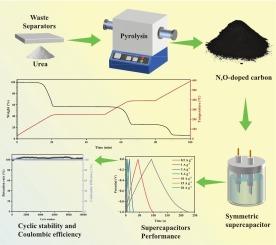用于储能应用的废电池分离器的升级回收
IF 8.9
2区 工程技术
Q1 ENERGY & FUELS
引用次数: 0
摘要
废旧电池的回收主要集中在正极材料和电解液的回收,而对电池隔膜的再利用关注较少。本研究提出了一种梯度加热和等温处理的尿素辅助热解策略,以实现废旧电池隔板的高效回收和增值利用。通过调整热解方案,分离器成功转化为具有分层多孔结构和高达2083 m2 g−1的高比表面积的碳材料。电化学测量表明,在0.5 a g−1电流密度下,碳电极的比电容为321.1 F g−1,在3 a g−1的高电流密度下,循环10000次后电容几乎保持不变。利用所获得的碳材料组装的对称超级电容器在250 W kg - 1的功率密度下,能量密度为9.1 Wh kg - 1。这项工作不仅为电池隔膜的资源利用提供了新的途径,而且为开发绿色可持续的储能装置提供了技术支持,兼顾了环境效益和经济效益。本文章由计算机程序翻译,如有差异,请以英文原文为准。

Upcycling of waste battery separators for energy storage applications
The recycling of spent batteries has primarily focused on the recovery of cathode and anode materials, as well as electrolytes, while little attention has been paid to the reuse of battery separators. In this study, a urea-assisted pyrolysis strategy involving gradient heating and isothermal treatment was proposed to achieve efficient recycling and value-added utilization of spent battery separators. By tailoring the pyrolysis protocol, the separators were successfully converted into carbon materials with a hierarchically porous structure and a high specific surface area of up to 2083 m2 g−1. Electrochemical measurements revealed that the carbon electrode exhibited an excellent specific capacitance of 321.1 F g−1 at a current density of 0.5 A g−1, and maintained nearly unchanged capacitance after 10,000 cycles at a high rate of 3 A g−1. The symmetric supercapacitor assembled from the obtained carbon material delivered an energy density of 9.1 Wh kg−1 at a power density of 250 W kg−1. This work not only provided a novel pathway for the resource utilization of battery separators but also offered technical support for the development of green and sustainable energy storage devices, balancing both environmental and economic benefits.
求助全文
通过发布文献求助,成功后即可免费获取论文全文。
去求助
来源期刊

Journal of energy storage
Energy-Renewable Energy, Sustainability and the Environment
CiteScore
11.80
自引率
24.50%
发文量
2262
审稿时长
69 days
期刊介绍:
Journal of energy storage focusses on all aspects of energy storage, in particular systems integration, electric grid integration, modelling and analysis, novel energy storage technologies, sizing and management strategies, business models for operation of storage systems and energy storage developments worldwide.
 求助内容:
求助内容: 应助结果提醒方式:
应助结果提醒方式:


